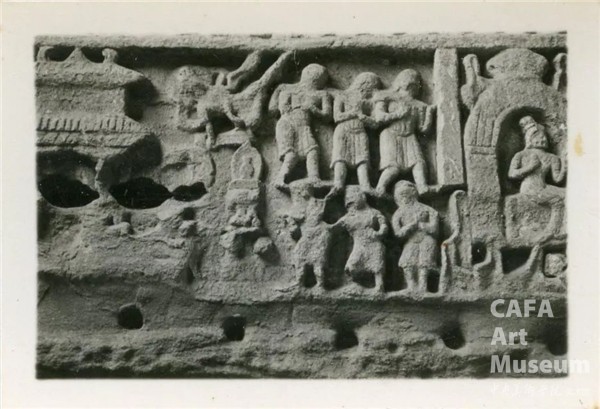
上世纪50、60年代,滑田友与雕塑系老师们前往中国古代雕塑遗迹进行了多次调研。滑先生为当时的古代雕塑调研做了很充足的准备,比如详尽规划了调研路线,更是携带颇为先进的照相机,对当时的调研状况做了完备的图像记录,并在考察后撰写了多篇调研成果综述。“勿失毋忘——雕塑家滑田友诞辰120周年纪念展”展览收集并整理了这些文献,在“田野考察记——滑田友调研传统之路”单元集中呈现,让观众得以回溯滑田友先生为中国古代雕塑研究做出的诸多努力。

“田野考察记”展出现场,滑田友采集的调研状况照片陈列在高低错落的抽屉盒里

滑田友调研时携带的相机及配件,由滑田友家属提供
这次访问四川的主要目的是对我国古代雕塑进行调查研究。了解古代艺术的来龙去脉,如何开始,如何继承,如何发展,什么地方可以有批判的接受和利用到现在的雕塑上来,达到古为今用的目的。

1963年滑田友在四川的留影,照片由滑田友家属提供
一九五三年我曾到华北,西北,山东等地访问过一次,看到的东西很多,但由于地区限制,有些朝代的东西还未看到,如唐代的泥塑,宋代的石刻以及清代还有些东西没有看到,因此不能把整个雕塑艺术从开始到现在联系起来,比如唐代的雕塑除在龙门看到之外,麦积山虽有唐代的洞子,但只能看到宋代的东西,宋代的也只看到泥塑,没有看到石刻。我们知道,对一个传统的东西,如果看到的只是一、两种,是不容易比较和判定每一朝代究竟如何的。这次参观访问正好把以前的缺憾补充起来。不过时间究竟有限,来不及把所看到的石刻上的文字记录记载下来,更没有进行时代背景的研究,暂时只能大概谈一谈从所见到的各朝代作品的创作方法及其风格变化和继承关系,及在访问中的一些感想略微谈一下。

麦积山石窟外观,照片由滑田友家属提供

麦积山石窟泥塑,照片由滑田友家属提供
汉代
汉代的东西,在重庆有大幅的画像石(石壁画)、画像砖;成都有汉代的陶俑、舞俑、说书俑;乐山有汉代的崖墓、浮雕;以及西安的茂陵石雕,内容十分丰富。
汉代的东西给我们很多的启发,尤其是浮雕和线刻,我从前看到一些汉代的东西,总有一种想法,以为汉代的浮雕和石壁画没有什么分别,所谓浮雕,只是把线刻的空白刻的低一些就是了,只是线刻的进一步变化,比较原始。譬如武梁祠石刻,孝堂山石刻,但这次看过之后,改变了我的看法。这次所见的崖墓里的汉代浮雕与汉代石阙是一样的,就是有体积,有起伏,有光暗,有立体感的真正的浮雕。因此而知,武梁祠石刻、孝堂山石刻,以及沂南的画像石就是线刻,不是浮雕。这两种雕刻都是有较高水平的艺术品,应当看成是各有不同的表现方法,是有意为之的一种风格。后来看到唐代永泰公主墓线刻就更证明这一点。
崖墓,是在山崖上开凿的大型墓穴,前边有门,门内有一个厅,厅的后壁又有一个洞放置棺材,门的里外,厅的四周都有装饰浮雕,就是崖墓浮雕。崖墓浮雕有各种各样的题材,如荆轲刺秦王,孔子见老子,拉马,钓鱼,谈话,套车等。全是描写生活的构图,都很活泼生动,描写细致,比起以前我所看到的呆呆板板,平平静静的宗教艺术,叫我感到意外。现就《荆轲刺秦王》一幅谈一下。

乐山崖墓,照片由滑田友家属提供

乐山崖墓“荆轲刺秦王”,图片来源于乐山崖墓博物馆
荆轲刺秦王可算是一幅构图完整的浮雕,整个画面是一长幅,全幅分成四格,中间一格刻成一根柱子,柱子的右面一格里是荆轲,面向着柱子左边的秦王,上身向前倾斜,一腿向后伸直,一腿向前提起,表示向前奔,荆轲向前奔去的力量抵住。柱子的左边是秦王,秦王的动作也是向左跑,逃避荆轲的袭击,同时回头看着荆轲,他的右手举起,像是在拔出背上的剑,表示在紧急之中还想还击。正如《史记》中所说,有人在旁提醒秦王“背剑。”在秦王前面另一个格子中,描写秦王的两个侍从惊惶失措。另外在荆轲后面的格子中还有秦午阳把樊于期的头扔在地上,匐伏在地不敢动。秦王和荆轲中间的柱子上围绕了一根带子,有人说是荆轲用匕首割下的秦王的一只袖子,也有人说是荆轲的匕首,荆轲击秦王未中,把匕首插到柱子上去了,这究竟如何,还不敢断定。但如果是匕首,那就是说这时荆轲已失去匕首,才有武士敢来阻挡。更证明这幅构图的描写周到,恰到好处,表现了这个故事的最高潮。如果描写在这个时机之先,或是在这时机之后,全不能表现荆轲的不可一世的英雄气概。也不能描写出击秦未中的紧张剧情。作者选择这一刹那是最适宜的,看出汉代创作的水平。
另外,在艺术形式方面有几点值得注意,就是以形来写神。荆轲追秦王的姿态,上身向前斜倾,一腿向后伸直,全身形成一条直线,造成向前奔去的整体。前面手高举,抛出匕首,前腿提起,更帮助向前追去的力量,从而形成一种势不可挡的气势。另外抱住荆轲的武士,两腿撑开,两手用力把荆轲拦腰抱住,上身向右斜倾,与腿也形成一个整体力量,与荆轲对抗。但荆轲的力量并未减弱,两人相比之下,形成一种蓄势,使人感到荆轲更为有力。秦王的动作也向前奔跑,做一种向前倾斜的姿势,并同时一手拔剑一面回头看荆轲。如果一直向前跑就不能形容尽致,而描写他向前跑中能够“背剑”和准备反击,如此全身也形成一个整体,这种既向前又转回来的神气,也形成一种蓄势,加上两边的秦王侍从的向前惊慌逃跑和后面的秦午阳的匐伏在地,形成有舒展,有间歇,有起伏,有顿挫,有音乐节奏的变化和韵律。整幅画面既奔放又含蓄。本来这种一格一人的构图是容易显得空的,而现在并不觉空,这是一种诗的组合,叫人看过之后常回味,不能忘掉,有余音杳杳,绕梁三日之感。这幅比武梁祠更完整,因为武梁祠的构图只有中间武士抱住荆轲比较好,而两边构图就不如这幅完整,而且只是平面的线刻。
这幅浮雕虽然已年久磨蚀,斑驳不堪,但还可以看出上面有起伏,有体积,有光暗,线条流利,形象真实。所以这幅作品在取材方面,构图方面,描写刻画方面,艺术处理方面都有很高的水平。与孝堂山,武梁祠的比较起来更雕塑化,更完整。当然这都是从艺术技巧方面看的。
从这一幅再结合别的汉代作品来看,汉代艺人是一方面追求写实写形,整体感非常之强,另一方面善于描写神态,在不断地追求表现生动活泼的思想感情。他们根据实际首先抓住所要表现的精神状态,然后才进行描写,描写方法是有时用近乎直线的有力线条,有时用连续不断地有节奏感的线条;有时是用大的曲线来归纳。并根据神似的目的,有夸张,有简化。初起是多方面探求,后来才在最成熟的作品上找到直线和曲线,依据规律找出节奏,巧妙的集中安排,描写出非常生动,感情自然的作品来。不单表现人是如此,表现马,表现人和马的大幅构图,小幅构图皆用同样方法。武梁祠石刻就是用三条大的近乎圆的线条,切合实际地把一个马生动活泼地圈出来了(自然不是用圆规画出的几何线去套在马上,而是在表现马的肥壮的部分采用近乎圆的线条表现出来的),然后再用近乎直线的线条配合着来描写马的矫健的四蹄,这样就创成一种大形大线并有韵律有节奏的作品。
我在山东、山西、河南、陕西、四川等地区所见到的线刻、浮雕、圆雕等等虽有作品的类别不同,地方性区别,以及风格的不同,但基本表现方法大体一致,而且一直影响到魏晋、三国时代,甚至南朝栖霞山墓饰都是一致。所以我揣想汉代艺人是在各地方流动工作的,并且互相影响。我感觉到对他们所用大形大线的以形写神的方法,还是有必要学习研究,和考虑应用到我们现代的作品上来。


霍去病墓石雕,照片由滑田友家属提供
北魏
这次我们所看见魏朝、晋朝以及六朝的作品不多,但是可以想到汉代的方法是在不断被采用而且发展着,其中有变,那就是外来民族侵入所造成。
北魏拓拔氏入主中国,起初文成帝无佛,但到孝文帝时却兴佛。因为他看到势力渐衰朽,有必要借用印度宗教和艺术的力量去迷惑人心,教人忍耐痛苦,为他们服务,巩固其在中原的统治。他用帝王的威力组织了一种宗教艺术的潮流,开辟洞窟。像开云岗、龙门、敦煌等这些洞子,就是遵守印度宗教的规格,用中国传统的艺术手法做出来的。所谓宗教规格,就是每一洞窟,中间以佛像为主,佛像的两边站着迦叶和阿男,外边是菩萨,再外边是力士和天王,再外边是两只狮子,最外边洞口处是供养人的位置,洞口上是飞天,由少而多,逐渐发展,例如昙跃五洞,主要的几乎只有佛、迦叶和阿男三人,而后来的洞窟就渐渐人多。另外,佛像本身也有规格,如佛的动作,面容皆有规定。开凿昙跃五洞时,中国艺人一方面遵守宗教的规格,一方面使用汉代传统的大形大线及互相配合的方法做出佛像来。于是外来规格和中国的手法这两种一旦结合,造成一种意外的收获,出现了更大气派的中国宗教艺术。

雕塑系教师在云冈石窟考察,左起曾竹韶、王合内、王临乙、滑田友。照片由滑田友家属提供

云冈石窟第20窟,照片由滑田友家属提供
汉代以后在艺术主流转入宗教艺术的情况下,有一件值得注意的事,就是因为利用艺术为宗教服务,把写人的生活这件事挤到次要地位。例如,昙跃五洞的大佛高有十来丈的,有七八丈的,而供养人和飞天的大小,仅有一二尺高,相形之下,描写人的生活方面受了限制。可是中国艺术的发展,是一方面按着佛教的规格,不出规范地尽量依着尺寸手势,坐和立的形状描写佛,一方面却也在尽量改变这种气氛,尽量刻画佛像,使他合乎人的精神状态,使用长圆的头,大弧线的肩,大圆桶的身躯和四肢,加上大线条的衣纹勾出他们所宣传的佛的伟大的气概和神态来,而且依人的思想感情表现佛的庄严美丽,表现佛的慈悲及和蔼可亲,既伟大又接近人。云岗第五洞的大佛高六七丈,宽七八丈,占了整个一个洞,但这个佛被安排的很巧妙,当人走进洞口的默拜处,可以看见佛的全体,并且使人感到佛的眼睛正看着自己,感到佛在安慰自己,叫人感到温暖。

云冈石窟第19窟,照片由滑田友家属提供
另外,中国艺人还是尽量刻画供养人,凡有供养人及飞天等,有人的生活气味的地方,都尽量细致描写,发挥着汉代的流利线条和生动活泼的传统。如云岗第五间第六洞的一些佛行传。第七洞、第八洞的供养人就逐渐加大。甚至从前都是放在很小很偏的地方的供养人,到后来却放到佛的面前和中间。在龙门,大幅的礼佛图就创造出来,生活也跟着描写出来了。而佛的面型也由印度人的面形逐渐改为中国人的面形了,那时的佛已渐被中国化,但总的说来,还是受印度的规格限制。北魏重要的变化是汉代描写人的活动,不问王公大臣与平民,多半从描写生活出发而为封建服务的。北魏开始之后,主要是为宗教服务,按照宗教的规格,艺人对生活的描写也只能在供养人身上得以体现。


云冈石窟,照片由滑田友家属提供
隋代
这次看到隋代的一些洞子觉得它的规格没有什么变化,但在佛像的体积上有显著的变化,像似进一步想摆脱印度的规格。广元皇泽寺有个立着的佛像,上身与下身连成一块方方正正的方筒,在整个方的中间,可以找出人的体格,然后用流利的衣纹线条来破方形,使他比较柔和。头部也是在方的形上抹去棱角,在转角处稍圆一下,形成方中有圆的面形。

广元皇泽寺,照片由滑田友家属提供
初看这个佛像的整体好像有点蠢笨,但仔细玩味它的方方正正的体形,流利统一的线条,柔和微妙的手势,细致刻画的装饰,调和统一。这样就突出一种强烈的和平与稳定的感觉,令人感到非常舒服,而且很协调。由于他们在造型上多方面探索,做到外方内圆或圆中保方,并且可以看见内部较细致的动作,因此使人走到跟前看而又看,不想马上就走。这种隋代的风格,不止这一处,像山东驼山、玉函山都有这样的作品。西安隋代的作品也是一样,比较硬,虽然还有点北魏时外来的影响,却已溶化到中国气派之中。这大概就是隋代的特点。
唐代
这次在乐山看到了唐代的大佛及离大佛不远的唐代洞窟。在广元看到了唐代的千佛岩。千佛岩的洞窟虽被这次在乐山看到了唐代的大佛及离大佛不远的唐代破坏了三分之二,但仍有唐代的代表性。可看出,唐代艺术是跟着隋代之后继续变化下去,而又进一步中国化。
唐代洞窟和北魏、隋代的规格一样,都以佛像为主,不过这些佛像已变化很多,比隋代更接近人,是随着人的具体形象加以概括做出来的。头部形象描写都栩栩如生,把耳、目、口、鼻各部仔细分析,成各个个别的整概括起来,成一个不易忘记的形象,因此做出来的作品体而又互相配合起来,并把头的总形用一种有力的总线既细致又生动。

广元佛教造像,照片由滑田友家属提供
描写身体时,能在衣纹底下看见肌肉与骨骼,透过衣纹看见躯体。形成一种有力的特点,整体统一,部分分明,温和圆润,结结实实,已不像隋朝的方方正正,而是圆中有方。把身体各部做出很显著的形和很显著的动作互相配合起来。如肩部、胸部、腹部、臀部都有切合实际的具体形状,而各部的形,又是随着动作互相组合起来的。其配合方法是以人的中心线为标准,比如站着的人,从头部顺着中心线到胸部的中心点做为一个转折、胸部到腹部又是一个转折,然后腹部直到脚,又是一个转折。每一个人都有这样的中心线和转折点。这些转折点不独在正面可以看出,在侧面也可看出来。比如在侧面看,由头部到脊背一个转折点,再由脊背到腹部一个转折,由腹部到脚再是一个转折点,形成一个整体。人头的方向,胸的方向和腹部的方向都随着动作而变化。同时又使用一种大形大线,大的轮廓或衣纹线条把整个身体统一起来。也就是把整个个别部分似有似无地隐藏在一个整体之中。唐代还发展了隋代的各种比较微妙手势和流畅潇洒的衣纹。因此唐代的作品既整体严整,又活泼细致,既裸露又蕴藏,比隋代以前有很大的改变,比以前各代皆生动活泼,富于思想感情,叫人感到既真实又优美,这是唐代特创的风格,摆脱了以前所有的作法。
唐代敦煌彩塑我没有看见过,但就我在乐山和龙门所见过的那样巨大的圆雕,广元、巴中那样多的小龛,无论大小皆能同样地细致刻画和描写,不独刻画佛像如此,供养人的构图和一切生活题材的构图、陶俑墓饰全是如此。另外唐代艺术不仅发展新的风格,同时也能保存前代优秀的遗风。如在西安所见的唐代墓饰犀牛、狮子、马一类的动物,还保留了汉代,北魏及隋代的风格,在大足北山所见的晚唐、五代和宋朝的作品,又随着唐代继续发展下来。

乐山大佛,照片由滑田友家属提供

1963年滑田友在乐山的留影,照片由滑田友家属提供

西安碑林博物馆藏献陵石犀,照片由滑田友家属提供

西安碑林博物馆藏昭陵走狮,照片由滑田友家属提供
宋代
宋代的石窟,不论北山还是宝顶,最先给人的印象是生活化。把佛描写成更近于生活中间的一个人。尤其是在大足的宋代石刻中间,看出宋代善于细致刻画人的精神面貌,思想感情。看出是在恢复原有描写生活的中国传统。创作一种突破外来宗教艺术的平静表情,大胆的表现人。表现人的技术非常进步,不单在描写人时的比例完全正确及动作生动活泼,并且进一步描写衣纹。宋代衣纹较厚,已从唐代的薄衣露体的手法转到表现人在厚的衣服中的状态。可以说既发展了唐朝流利的线条,又恢复汉代用衣服来描写人的气概的技术。因此宋代的雕塑就出现了一种流利大方,气势雄浑,栩栩如生的作品来。像北山的文殊普贤,像宝顶大佛湾的父母恩重经变相图,六师外道毁谤佛教图和佛行孝图,皆吸引人和感动人。形成了宋代特有的风格。

北山文殊菩萨像,照片由滑田友家属提供

北山普贤菩萨像,照片由滑田友家属提供
宋代虽然突破北魏以来的宗教规格,但并没有脱离为宗教服务,相反地更为有效地为宗教服务。大足宝顶的大佛湾的表现,突破佛教的老范围,借人的生活进一步宣传宗教,把宗教所需要的事迹加以宣传,借用艺术工具,用大篇幅的生活图景与佛经一唱一合宣传宗教,使人不知不觉地走入迷途,信仰宗教。
一进大佛湾的门,左手的山岩上刻了十种牧牛图,其大小与真人一样,描写了各种牧牛的不同形象。在捉捕野牛的图中,有的在前拉牛,有的人在后面赶牛,用鞭子抽牛。在训练到驯服的画面中,有两个牧人在一起玩要嬉笑,另有的在爬山,有的在睡觉,而牛在旁边喝水,舔蹄,匐伏在地或者蹭痒等等。表示牛已完全驯服,生活自如,俯首听命。这段描写生动活泼,形象真实有力,叫人看而又看,尤其是农民,最感兴趣。他们不拘什么内容,只捡他们所喜爱的牛,便烧香默拜,祈祷他自己的牛也能达到同样的健壮。可见艺术的力量,到了使农民相信不疑。但是最后一段却刻了大佛湾创建人赵智风的形象,端坐在后边,还题了一首诗在岩上说:
无牛人自镇安闲,
无往无依性自宽。
以此分明谁是侣,
重山峻岭与岩泉。
意思好像是说人无论把牛驯得多好,也不如放弃耕种,修行苦练为好。


大佛湾牧牛园,照片由滑田友家属提供
再右边是一洞,洞里刻的是许多佛像,表明成佛后的快乐。
大佛湾大门的右边,布置了九个护法天王,雄伟壮健,形象凶恶,刻画得细致准确,使人惊心动魄。再右刻了六道轮回,善人升天成佛或作恶犯罪的人打下地狱变牛变马。里边是三尊大佛,再里是千手千眼观音。把手刻得千变万化,细致微妙,表示佛的威力,无往不及,无论你逃到那里全能把你抓回来。再里是卧佛,佛的死亡,再里转弯处,刻着佛的降生,说明佛生的渺小,死的伟大,或者不生不灭。再往里转即大门的对面是毗卢洞,刻佛的救苦救难。再往里是十种父母恩德变相图。描写父母求子、怀孕、生子、抚养、把尿、温被窝、教育、为子结婚、送子出行,各种各样父母对子女的恩德关系。生动活泼,叫人看而又看,甚至有些人丢钱到洗孩子的澡盆里,或喂猪的猪食盆里,说投中了就可生子。但在父母为儿子结婚的底下角,刻着一小块地狱受罪的情况。注明就是因为杀猪请客,吃酒排宴,犯下了罪,虽然生时享尽欢乐,但死后就得打下地狱。

大佛湾石窟,照片由滑田友家属提供
再里便是六师外道谤佛图和佛的行孝图。描写六师外道嫉妒佛,和不服佛教的道理,对佛进行毁谤,说佛出家不孝。艺人们把六师外道的形象尽量用夸张的手法,把六师外道毁谤人的丑态,描写出来。比如描写他们好说人坏话,就把他们的嘴巴夸张到三四倍大,直到不像人形,奇形怪状。但描写其他部分,如身体手足各处都是合乎比例,动作也生动活泼。因此就分外突出他们的狂妄。使人感到的确是歪道。同一幅的另一面,又描写阿男的反驳。说佛是孝顺。描写一些故事如,佛看父病,佛为父抬棺,佛舍身为人之类。好像在这些上边还和儒教在唱对台戏,所谓六师外道实际在影射儒教。另一部分又描写吃酒人的罪恶,酒后如何昏溃,父不识子,妻不识夫,姊不识妹等。还描写一个美丽姑娘捧着酒坛敬客,形象极为生动、很是幸福。但就在同一幅中间划了一条斜线,线的那一边,就是那个美女本人,由于她在阳世行酒犯罪,在阴间就得受罪,变得丑陋非常,骨瘦如柴,受尽痛苦。还描写一个养鸡人,也上了刀山。这皆是利用艺术的力量宣传宗教的道理,说人在平常生活中不知不觉,因为吃酒杀牲都犯了大罪,死后就得打下地狱。


大佛湾石窟,照片由滑田友家属提供
最后是描写柳本尊十炼图,表示柳本尊由于信佛,跟佛走和舍已救人,能忍受痛苦,不起任何念头,不反抗强暴,所以能成佛成仙。这是完整的一套的利用生活来宣传佛教的道理,是别的地方所没有的,比以前所有的宗教艺术都较为大规模和宣传的计划性,而且以后有更大的发展。
另外大佛湾之所以能这样有计划性,我个人看法可能小佛湾就是他的前身。小佛湾就在大佛湾上边的庙里,内容和布局有许多部分和大佛湾相同,艺术性甚至比大佛湾为好。可能当时初创时候从这个地方开始,后来由干大众喜爱才发展再建大佛湾。
可以看出,中国汉代以后的雕塑艺术已被宗教所利用,随着宗教需要不断发展,由小到大,由没有计划到有计划,历代相承,逐渐发展起来。
从这次访问和一九五三年华北访问来看,艺术在技巧方面从汉代就有很成功的基础。南北朝外来宗教的渗入,利用汉代的描写生活为封建服务的手法为宗教服务。到了隋唐就完全转变为中国气派的艺术。宋朝更进一步改变了以前的宣传方法,更恢复了中国原有的生活气息的艺术,利用大量对生活的描写为宗教服务。元代永乐宫的建筑、绘画、雕塑三结合的大排场设计,明代平遥双林寺的大规模设计,清代一些大庙宗宇的五百罗汉,以及所有各地的东岳庙、阎罗殿的设计,皆是在宋代的基础上一步步发展起来的。其中有一点值得注意的,就是北魏外来民族的侵入,给中国古代雕塑带来了很大的好处,促进了中国雕塑的发展,但元代和清代外来民族的侵入却造成中国艺术的衰落。元代初,虽有永乐宫那样的好东西,但末期衰落。明代虽曾做过很大努力,头像虽曾得到恢复和发展,但全身整体感仍感到有缺陷。清代更是如此,不但不被重视,反而有所摧残,最终走向衰落。虽然清代五百罗汉做得很生动活泼,而且塑造很多,千变万化,但由于只重视宣传,不重视技巧,在组织结构上失掉传统,整体感不强,与唐宋相比,就感到空虚,在艺术性方面不能耐人寻味,不够吸引人。

平遥双林寺罗汉像,照片由滑田友家属提供
近代
清代末年,尤其在1900年以后,八国联军,帝国主义侵入中国,劫去很多中国古代文物,引起中西艺术大转变,即中国艺术传入西方,而西方艺术传到中国。在西方,很多西方艺术家吸收了中国艺术气韵生动的方法,做出许多生动的,体积饱满的作品。在我看来,画家马蒂斯,雕塑家罗丹和他的学生就是吸收过中国的大线和近代泼墨的艺术手法。但由于只从写实出发,而未注意到中国艺术的形式与思想内容相结合的方法,以致内容比较颓废,而他们的后一代逐渐脱离内容。
中国的艺术家开始学习西方艺术,这在清末艺术比较没落的情况下实在是好事。因为清代的东西,除了云南巩竺寺的罗汉形象非常生动和天津、石湾、潮州、无锡、景德镇这些民间艺术之外,在大规模的有份量的宗教艺术方面就比较失去传统。西方艺术对整体观念,组织结构,比例动作及细致刻画方面都有科学的分析。如果能把他们这些传统吸收过来,弥补清末衰落时期之不足,实在是好事。这时期,我国出了不少有名的画家,实际上是一时之盛,我不一一列举。这时期,我认为有一点是有缺点的,就是有些艺术家容易被具体形象牵制,较写实,只用力去描写形象,而没有去描写精神面貌,以致做出的作品使人感到是西洋成份居多。也就是说西方的艺术传入后,较失去了中国传统风格。

《云南筇竹寺塑像》封面,滑田友藏书,由滑田友家属提供

《云南筇竹寺塑像》内页,滑田友藏书,由滑田友家属提供
小结
在这次访问中,我常想一个问题。古代艺术作品确是美好、伟大的,有很大的吸引力。但我们是去访古迹的,是去看古代的优秀文化遗产,而很多人却是去烧香拜佛,是去看天堂地狱的。我觉得重要的问题是阵地和武器问题。信仰宗教是自由的,不信仰宗教也是自由的。宗教有阵地,我们当然也可以有阵地。但是今天我们所见名山、大川、名胜古迹,在中国最幽静最秀丽的地方都是为封建迷信所占领。他们磕头烧香,无非是为着现在和将来的幸福,不再受苦难。我们在峨眉山上看见雪山、瓦山,能不能就在可以看见的地方,而不是对台戏的地方,歌颂现在,去宣扬另外的一种求福方法。宣传革命的历史故事,说明今天的幸福并不是烧香拜佛得来的,而是通过革命斗争,生产斗争得来的。

雕塑系教师在乐山大佛考察,左起滑田友、陪同人员、王临乙、陪同人员、王合内、曾竹韶。照片由滑田友家属提供
我感到我们现在的创作是有些缺点的,一是生活体验不够,只有深入生活,才能对生活素材进行选择,综合提炼,取得最高潮的情节,才能丰富创作的内容。二是描写方法还要提高,雕塑做法基础是有的,但利用中国传统的以形写神的能力不够,以致不能神形兼备。
我认为,中国古代的艺术之所以有这样的优秀作品,有这样的宣传力量,主要是注意描写精神面貌,以形写神。所谓形,是指描写人的面形或人和物的整体及动作的形。描写时不是为了形而形,也不是写实的形,而是根据实际的形象和思想感情结合起来,综合概括出来的“应物象形”的形,有时是采用夸张的或简化的手法把原来的特点有所取舍的表现出来的形。所谓取,就是取其实际突出的部分,甚至夸张一点使其更突出;舍,就是实际形上不突出的部分,根据需要去掉,使之更不显著,这样使人感到形象更为明确有力,直到形象已突出的表达了精神面貌,或形象已不成问题,立即转入作品的思想内容的玩味和体会。这就是中国古代作品的优点,即中国传统风格和西方传统风格的不同之处。

滑田友考察山西永乐宫元代泥塑,此像今已损毁,照片由滑田友家属提供
另外,思想感情的表现也是一样,首先,思想寄于动作。身体有动作,面容有动作,表情也寄于动作。而动作也可以进行推敲,怎样做就生动,应当怎样夸张和提炼,能找出什么样的具体形来比喻,用几个形来组合。经过深思熟虑,迁想妙得,就更能使作品达到神似。
生活实际是千变万化的,根据实际创作的作品也就会千变万化。所以,我认为考察古代艺术,就要研究和体会传统艺术的表现方法,究竟如何夸张和提炼,去其粗,取其精,再根据现在生活实际情况和今天的要求,运用得到的规律不断追求,定能在技术上更提高一步,是雕塑艺术更适合人民的喜爱。创作出各种不同的形式而又发扬传统风格的作品,达到思想性和艺术性的完美结合。
文/滑田友
写于1963年8月
原载于《滑田友》画册
(人民美术出版社,1993年版)
展览信息

百年辉煌•中央美术学院艺术名家
勿失毋忘——雕塑家滑田友诞辰120周年纪念展
展览时间:2021年11月24日—12月26日
展览地点:中央美术学院美术馆二层B展厅
主办:中央美术学院
承办:中央美术学院党委宣传部、中央美术学院美术馆、中央美术学院雕塑系
总策划:高洪 范迪安
学术主持:苏新平
项目策划:秦建平
策展人:曹庆晖
展览总监:张伟 张子康 韩文超
展览统筹:王春辰 高高
特别支持:滑夏 滑玉
策展助理:易玥 李展
显示设备支持:BOE画屏
| 温馨提示 |
因校园疫情防控要求,美术馆暂停对外开放
校内师生可正常参观
